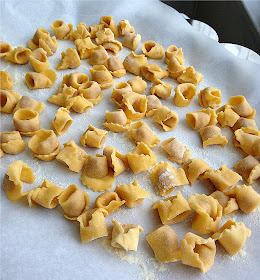You may spend hours in your kitchen making something (homemade cappelletti is one recipe that comes to mind) that gets eaten up in mere moments without much thought and then sometimes you make something of utmost simplicity that is received with grand applause.
Like the slutty girl with the too-tight mini dress, the plastic boobs and lacking brilliant conversational skills that manages to turn every head in a one-mile radius, some dishes get all the attention without really deserving it.
Don't get me wrong, I'm not saying these girls recipes aren't good, because they are, but they don't involve all the attention and expertise others do.
If you have leftover polenta and ragù (or some stew, or come to think of it any other type of leftover, because this girl gets around polenta goes with pretty much anything), it will literally take five minutes to prepare and a half hour tops to bake.
So I present to you the tart (no pun intended) of leftovers: the tortino di polenta e ragù, 'tortino' literally translating into 'little tart' in English.
When making polenta you can go two ways*: the real way, which involves lengthy stirring or electric devices you would only consider buying if you owned a ski pad in the Italian Alps, or the use of instant polenta. There is not doubt that the real deal is better, in flavor and texture, as all things made from scratch. But the difference is subtle enough, especially when baking or frying the polenta afterwards, to justify (unlike instant mashed potatoes) using the quick-cooking variety.
Whichever way you decide to make your polenta, you will most likely have some leftovers because polenta just happens to be one of those dishes people tend to make in large quantities. Ragu being another: I usually make it in large batches and tuck some away in my freezer for emergencies.
If you don't have any ragù, a whole list of delicious leftovers you can use come to mind: all kinds of vegetables (broccoli rabe sauteed with olive oil, garlic and anchovies anyone? or mushrooms with parsley and garlic), bits and pieces of leftover cheeses, any sort of fish cooked in sauce (codfish works wonderfully), mozzarella and ham... the list just goes on and on.
ragù
polenta
butter
Parmesan cheese, grated
pepper
olive oil (optional)
Polenta
1.1 lbs/500gr polenta
9 cups/2 l water
1 tbsp olive oil
salt
To make the polenta (if starting from scratch) the old fashioned way, bring water to a boil, reduce heat and salt the water to taste. Add in a tablespoon of olive oil and then slowly pour in the polenta (to avoid lumps forming), stirring constantly with a wooden spoon or whisk until the polenta has thickened. This takes anywhere up to 45-60 minutes. If the polenta is getting too thick you can loosen it by adding some water as you go along. Mix in any ingredients (cheese, butter etc.) you intend to use and pour it out onto a smooth surface, like a cutting board, or into a bowl and let stand for a few minutes before serving. I usually keep mine a little runny because that is the way I prefer it and it makes it easier to work with leftovers.
If going instant, just read the instructions on the back of the package.
If going instant, just read the instructions on the back of the package.
Pour the polenta (or spread leftovers with a spatula) into a greased baking pan. Spread over a layer of ragù or whatever else you are using. Sprinkle with some grated Parmesan cheese and keep layering until you have finished using up the leftovers. Sprinkle with a last dusting of grated Parmesan cheese, add a few flakes of butter and bake in a preheated oven (375°F/180°C) for about 30 minutes, until the top and sides turn golden and crusty and the filling is nicely heated.
Using a deep pastry ring (what they call a coppapasta in Italian), cut out circles from the pan and serve on small individual plates. Dust with Parmesan cheese, pepper and trickle of olive oil and serve.
*While writing this post I actually discovered there are other ways to make polenta from scratch that are much simpler. There is a 12-minute microwave version and another one involving a great amount of time (more than 3 hours) but very little stirring. Who knew? I intend to try them at some point and let you know.
















